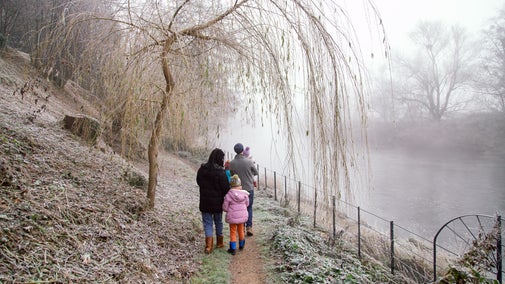Watlington Hill and the Wormsley Estate walk
Oxfordshire, Buckinghamshire & Berkshire
This is a long and fairly challenging walk taking you around Watlington Hill, Pyrton Hill, Cowleaze Wood and the Wormsley Estate, with opportunities to see rare and endangered chalk grassland and woodland habitats, fine views and the grounds of the former home of the philanthropist Sir Paul Getty. The walk offers spectacular views over Watlington and the Vale of Oxford, as well as the Chiltern Escarpment.
Near to
Chilterns CountrysideStart point
National Trust car park at Watlington Hill, grid ref: SU709935Trail information
*Long walk over difficult terrain, with some steep gradients. For further details, please see Terrain section.
**Uneven terrain with a number of obstacles along the way, including stiles and gates. For further details, please see section marked Access.
***Dogs under close control welcome. For further details, please see section marked Facilities.
More near here
Coombe Hill and Chequers trail
Enjoy a moderately energetic circular walk from Coombe Hill, taking in views across the Aylesbury Vale. You'll wander through woodlands, past rare chalk grassland and the pretty village of Ellesborough.

Hambleden Mill to Henley-on-Thames circular river walk
This circular Thames walk takes in a historic watermill, the Henley Regatta course, views across the Thames Valley and quiet stretches of river with the chance to spot wildlife.

Coombe Hill Woodland Walk
Follow this gentle circular trail in the Chilterns through beech woodland to the top of Coombe Hill, with far-reaching views from its summit.

Hambleden and Pheasant’s Hill trail
Visit rural hamlets, stroll through beech woods and enjoy views across the Hambleden Valley on the Hambleden and Pheasant’s Hill trail.

Get in touch
Chilterns Countryside, c/o Hughenden estate, High Wycombe, Buckinghamshire, HP14 4LA
Our partners

We’ve partnered with Cotswold Outdoor to help everyone make the most of their time outdoors in the places we care for.
You might also be interested in
Walking
Explore some of the finest landscapes in our care on coastal paths, accessible trails, woodland walks and everything in between. Find the best places to walk near you.

Visiting Watlington Hill in the Chilterns Countryside
The wonderful views, rich chalk grassland and downland of Watlington Hill make it a perfect place for walks and wildlife spotting.

Things to see and do in the Chilterns Countryside
Discover the countryside sites of the Chilterns. Find the best viewpoints, walk through ancient woodland or pick a quiet spot to watch for wildlife.

Walking in Oxfordshire, Buckinghamshire and Berkshire
From gentle strolls for little legs to longer hikes through the rolling Chiltern hills, these are some of the best walks in Oxfordshire, Buckinghamshire and Berkshire.

Staying safe at National Trust places
The special places in National Trust care sometimes come with a few risks for visitors, be it coastline or countryside. Find out how to keep safe throughout your visits.

Follow the Countryside Code
Help to look after National Trust places by observing a few simple guidelines during your visit and following the Countryside Code.

Cotswold Outdoor: our exclusive walking partner
Learn about the National Trust’s ongoing partnership with Cotswold Outdoor. Find out how they help us care for precious places and the exclusive discount available for National Trust supporters.



